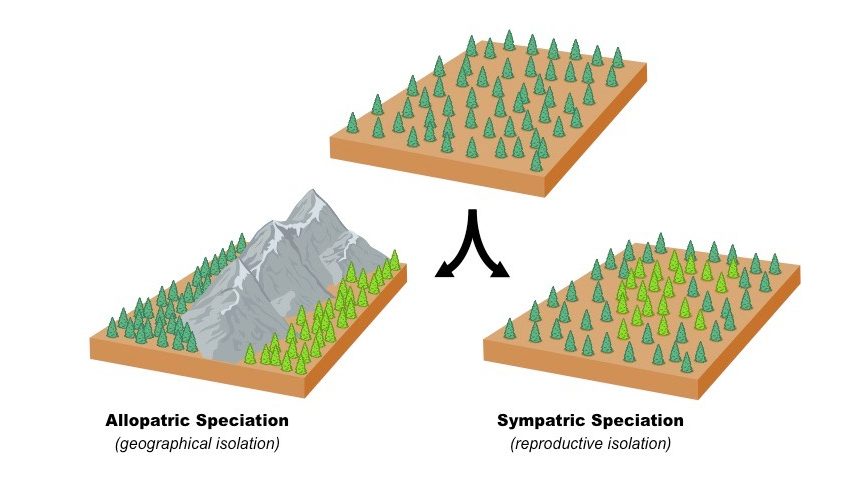Speciation refers to the formation of new species. Allopatric speciation and sympatric speciation are two major mechanisms of speciation. They both occur due to the reproductive isolation of individuals in the same species.

What Is Allopatric Speciation?
Allopatric speciation is the physical isolation of a biological population by an extrinsic/geographical barrier such as mountains, rivers, lakes or due to changes in land topography. The geographical barrier isolates the two populations from each other and thus, even if their environments are similar, genetic drift will always result in them becoming genetically different from each other. Therefore, after a long period of evolution while isolated from each other, the two populations will no longer be able to interbreed even if they do come into contact again.
Allopatric speciation is considered the dominant mode of speciation among most groups of organisms. It is easy to see how things like appearance of a mountain range, canyon or body of water could isolate populations of organisms. Also, research has shown that, the greater the distance of separation, the greater the odds that speciation will occur. Two examples of allopatric speciation are Darwin’s Finches and populations of squirrels in the Grand Canyon.
What Is Sympatric Speciation?
Sympatric speciation is speciation that occurs when two groups of the same species live in the same geographical area, but they evolve differently until they can no longer interbreed and are considered different species. In sympatric speciation, there is no geographical boundary; something else must be responsible for the population’s divergence. Usually, sympatric speciation is unique and not very easy to understand because it takes place while two subpopulations of the same species are occupying the same geographical area. However, it may come down to some barriers either pre-zygotic or post-zygotic; that prevent gene flow, for example mating different times of the day.
Some of the examples of sympatric speciation include: The cultivated wheat, corn, tobacco and the African tilapia. Also sympatric speciation can be observed in many different types of organisms such as the apple maggot fly, bacteria and cichlid fish; however it is usually not easy to tell when sympatric speciation has happened or is happening in nature.
Similarities Between Allopatric And Sympatric Speciation
- Both allopatric and sympatric speciation happens through the reproductive isolation of individuals in a population.
- Both processes result in evolution of a new, distinct species from the pre-existing species.
- The resultant new species in both processes are incapable of interbreeding with the pre-existing species.
- In both processes genetic modification occur in the population.
Difference Between Allopatric And Sympatric Speciation In Tabular Form
| BASIS OF COMPARISON | ALLOPATRIC SPECIATION | SYMPATRIC SPECIATION |
| Description | Allopatric speciation is the physical isolation of a biological population by an extrinsic/geographical barrier such as mountains, rivers, lakes or due to changes in land topography. | Sympatric speciation is speciation that occurs when one or two groups of the same species live in the same geographical area, but they evolve differently until they can no longer interbreed and are considered different species. |
| Cause | Geographical isolation leads to reproductive isolation and speciation. | Indistinct/unknown factors could be attributed to be main reason behind sympatric speciation. |
| Speed Of Evolution | Speed of evolution of new species is slow. | Speed of the emergence of new species is fast with autopolyploidy and slow with allopolyploidy. |
| Geographical Isolation | The populations are geographically separated. | The populations are not geographically separated. |
| Common | Common in nature. | Common in plants. |
| Major Differentiation Mechanism | Major differentiation mechanism is natural selection. | Major differentiation is polyploidy. |
| Examples | Some examples include: Darwin’s finches Squirrels in the Grand Canyon. | Some examples include: Cultivated wheat Corn Tobacco African tilapia |
| Entails | Allopatric speciation involves one population. | Sympatric speciation involves two or more populations. |
Summary
- Sympatric speciation is rare and occurs mostly in plants as self fertilization. Polyploidy is common in plants when compared to animals.
- Sympatric speciation usually happens through polyploidy. A diploid individual cannot interbreed with tetraploid individual leading to reproductive isolation.
- In allopatric speciation, the chance of interbreeding between these populations is next to zero.
- In allopatric speciation, each population acquires mutations by natural selection to adapt to the new environment. After a given time, reproductive isolation and speciation sets in separating two populations into two species.